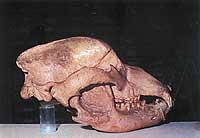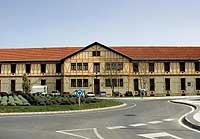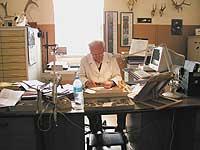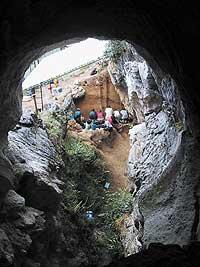Jesús Altuna: "Archaeology must be interdisciplinary".

Creation has always been interesting to me: The origin of the Earth, the origin of life, the origin of the human being, the birth of Euskal Herria...
After finishing my studies at the Seminar, I went to study biology in Madrid, and when Barandiaran returned to Hego Euskal Herria, I got in touch with him and started working with him. At that time only tools, human remains, etc., were investigated, but archaeology must be interdisciplinary. There was a lot of bones of animals without being analyzed. As I studied biology, Barandiaran proposed to take care of those bones and so I did. I took my bones and went to Madrid to do the thesis.
It was a relatively new archaeozoology, daughter of paleontology. It arose to study animals related to human beings, those who hunted, those who lived with them… And at that time no one did it in the whole state.
I started forming a collection of bones, but seeing the situation here I thought I had no choice but to go to Germany. In this area came the archaeozoology after the last great war, which had a beautiful collection and all the resources. He passed a terrible envy.
Every time I came here it was sad to see the situation here, but if you want to read a book, you must ever be on the first page.
What information can be obtained from the bones found?

In addition to knowing which animal belongs to, you can obtain great information. For this it is necessary to have skeletons of different ages. Analyzing the bones of Ekain, we have known, for example, that the human being lived in that cave from May to August. There have only appeared the skeletons of newborn deer babies, of one or two months, with unspent milk teeth. The only bones of adult deer are those of the females. The hunters knew that the female deer goes to a hidden place when the child is going to make, where it has breeding for twelve or fifteen days, until it accelerates. At that time they were captured by Ekain hunters.
In another case, in Marizulo, Urnieta, there appeared a man buried with two bones, one of lamb and another of dog without head. Archaeozoology indicates that the man was not a hunter, but a shepherd, and at that time had rites or burial customs.
The marks found in the bones can also give a lot of information. Brands of human origin can be found as tools, teeth or fire. Through them, habits and the way of life can be known.
Another of my research lines is rock art, in which archaeozoology also helps a lot. It is important to know the animals of each epoch in order to interpret the images.
What is currently the archaeological research in general in Euskal Herria? And archaeozoology?

Much progress has been made, especially since the birth of the university. Today we cover many fields and literature is written and published. Here we work scientists from different fields, palinologists, sedimentologists, studying tools, etc.
When I started, I started with mammals, which was what was most. Now in Euskal Herria we have other archaeologists working and many working groups have been formed.
The worst thing is that only with this work can not live. In the past, many jobs were created in teaching and this research was usually accompanied. If I like teaching much better and I liked it a lot. Today, however, there is no work in it and only with research can one not live. Many people with good training have had to leave out. There are human resources, but others are missing.
Is the work of the archaeologist estimated?

Appreciated by the people. They may not know exactly what we are doing, but they believe we are doing something important because we are investigating the things of our ancestors.
For example, we have had the collaboration of mountaineers. When we carried out the archaeological map in 1982, which reports megaliths and caves, it was acquired by many mountaineers. If we saw something special on the map, they called us to communicate it. In 1990 we published a new map with only megaliths, and many more appeared because in those eight years many were found.
It still warns us when people find something, even when there is something in danger of breaking or disappearing, and we go away. We do not always arrive on time, but we try.
On the other hand, formerly the institutions also had very bad opinion about us, especially until the change of regime arrived, because we studied Euskal Herria. Then we jumped a lot but it is not enough. I believe that more grants and wills are necessary for the research and conservation of heritage.
Is it difficult to protect heritage?

Sometimes yes. When it was found in June, for example, we had a strong pressure of tourist expansion. In 1969 it was discovered by two young people of Azpeitia, and until we had the door open we did not open the news. Both the mayor of Zestoa and the provincial authorities and those of Madrid wanted it to open to the public, as did Altamira. At the time in Altamira, three thousand people entered the day and that is why it was damaged. Lascaux, one of the most beautiful caves in France, was deteriorating due to tourism and so we said we did not open. But it cost us a lot.
The authorities were informed that the deposit at the entrance remained closed until their study and, fortunately, was accepted. Franco died soon. In 1975 we finished the excavations and managed to close them. In Altamira it was already said that things were getting much worse. June is preserved very well because it has not spread to tourism.
On the other hand, in the mountains and forests many tasks are carried out, many times necessary, but do not take into account the heritage. Not long ago, in the high of Igeldo a dolmen with a machine was destroyed. A monument that lasted 4,000 years was destroyed in an instant. We have not been able to analyze the meaning it could have for the human beings they built. Perhaps they did so to maintain the connection with the deceased, or to show the way in which he was buried, perhaps it would have made loneliness and tears less agile… And suddenly the useful and everything there, losing forever I do not know how many tons of land. There are many cases of this type, and it is necessary a great support for the heritage not to be lost forever.
How do you see the work here from abroad?

Well, especially because the works are published. We publish here the magazine Munibe and exchange it with many archaeological entities. Thanks to this, from abroad we receive about 500 magazines, including most of Europe. So, in addition to spreading our work, we form a beautiful library and are up to date. I think it is the magazine that diffuses most outside of Euskal Herria. The publication is fundamental to make known personal work. The work that is not published is not research, it is hobby. When a job is launched, exchange with others is very enriching. The others say what is well done and what is not, and can be compared with other works.
From the outside come many researchers to see and analyze the material we care for in our headquarters. In addition, they say they find the material in very good condition, all well classified and distributed.
What has been your favourite achievement of all these years?
June, of course, would be one of them, but there are many others, smaller, but they have given me much joy. For example, when I started, I found between the bones of Lezetxiki to the bone of a sweet badger. At first I did not know what it was. Jatuna is a cold climate that was the first discovered in the Iberian Peninsula. Then we didn't have the food skeleton to compare, and by descriptions and iconography I thought that could be, and then I could check it out. The appearance of an animal that expressed that the climate was so cold and that it was the first gave me much joy. Another of the great discoveries is the human bone discovered in Lezetxiki, which may be related to Atapuerca's findings.
Box filled inJesús Altuna traveled to Madrid with a bone box. However, his thesis director did not know anything about archaeozoology. They saw the need for a collection to classify the bones, and also had to start with zero. Thus, when the bullfighter Dominguín discovered that he should eat a deer hunted with his friends in a restaurant in Madrid, he went to the restaurant and asked for the remains of the dinner. The restaurant staff told him that there was no meat left, and he was surprised when he went with his bones and said he didn't need meat. It was the first step in the bone collection. He was in a Vespa looking for bones up and down on the Iberian Peninsula. At that time he met Koro Mariezkurrena and began to travel the way together. Then they bought a Seat 600 that brought them a big change and, of course, there entered many more bones than Vespan. Later, the skeletons were brought from Africa, Archic, Asia and other distant places. And little by little they built a large collection, and in it they continue constituting the best collection existing today in the whole state. It also enjoys great prestige among foreign researchers. Undoubtedly, a work throughout the whole of life. |
Buletina
Bidali zure helbide elektronikoa eta jaso asteroko buletina zure sarrera-ontzian











